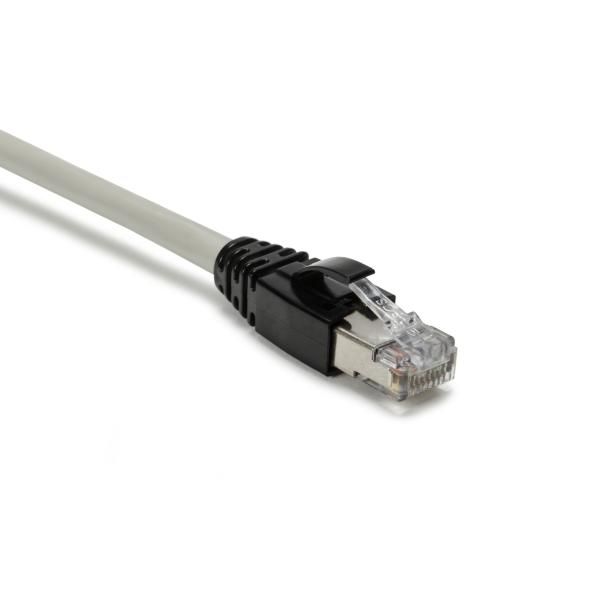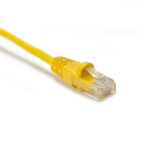Most people, even those unfamiliar with the intricacies of network technology, have probably come across a patch cord at some point. These simple yet critical components often go unnoticed but play a vital role in our connected world. Today, we'll explore what patch cords are, how they function, and the nuances that make certain types more suitable for specific applications.
Patch cords can be easy to overlook due to their ubiquity, but understanding their function and importance can lead to more informed decisions. Knowing what to look for in terms of quality and specifications could make all the difference in your network's performance and reliability.
What Are Patch Cords
Essentially, patch cords are flexible, insulated cables equipped with connectors on both ends. These connectors latch onto ports, facilitating communication between different network devices. Whether you're connecting a computer to a switch or linking two patch panels together, patch cords serve as the lifelines of your network.
Contrary to popular belief, not all patch cords are created equal. Different materials, lengths, and connector types can greatly influence the speed and reliability of your network. Opting for low-quality cords could result in data loss or even complete network failure, emphasizing the need to choose wisely.
Types of Patch Cords
Copper-Based Patch Cords
Copper-based patch cords, usually categorized as Cat5e, Cat6, or Cat7, are the most commonly used types in residential and commercial setups. These categories primarily define the cable's data rate and maximum bandwidth, giving you a clear idea of what each cable can handle.
While copper-based patch cords are affordable and easy to install, they do have limitations in terms of length. Exceeding these length restrictions could lead to signal degradation, resulting in slower data transfer rates or increased error rates.
Fiber Optic Patch Cords
If you're looking for higher bandwidth and less susceptibility to interference, fiber optic patch cords might be your go-to choice. These cables utilize light to transmit data, offering faster speeds and the ability to cover greater distances without a loss in signal quality.
Fiber optic cords are more expensive than their copper counterparts, but they also provide significant advantages, particularly in environments that require high-speed data transmission over long distances. Understanding the trade-offs is crucial when deciding which type to invest in.
Choosing Quality Patch Cords
Buying a patch cord may seem straightforward, but several factors should guide your decision. The most obvious one is compatibility. Make sure the connectors fit snugly into the devices you intend to link. A loose or incompatible connection can wreak havoc on your network's performance.
Another crucial consideration is the environment in which the patch cord will be used. Factors like temperature, humidity, and even electromagnetic interference can impact the cable's effectiveness. Therefore, it's beneficial to know the specifications and limitations of each cord before making a purchase.
Final Thoughts on Patch Cords
Patch cords may appear mundane, but their role in network infrastructure is anything but trivial. Whether it's a home setup or an expansive data center, the right patch cord can be the difference between optimal performance and constant troubleshooting. Armed with this knowledge, you'll be better prepared to make informed choices that will serve your network well.
Choosing the right patch cord doesn't have to be a shot in the dark. By understanding their function, types, and quality markers, you can select a cord that meets your specific needs, ensuring your network operates smoothly and efficiently.
Installation Best Practices
Importance of Proper Installation
When it comes to patch cords, installation isn't just a matter of plug-and-play. The way you install these cords can have lasting impacts on network performance. Incorrect installations can lead to complications like reduced data transfer speed, increased latency, and even system outages.
To avoid these issues, always adhere to best practices for patch cord installation. This involves steps such as keeping the cords untangled, using cable management solutions, and ensuring a clean connection between the cord and the device port.
Tips for Clean Installation
Getting the installation right doesn't require a PhD in networking, but it does require attention to detail. First, measure the distance between devices to ensure you're using a patch cord of the right length. Excessively long cords can become tangled and are more susceptible to damage, while short cords can pull or strain the connectors, risking damage to both the cord and the port.
Once you've chosen the right length, use Velcro ties or cable organizers to keep everything neat. A well-organized cable setup not only looks better but also makes it easier to identify and troubleshoot problems should they arise.
Maintenance and Troubleshooting
Routine Checks are Key
Patch cords, like all hardware components, have a finite lifespan. That's why routine maintenance checks are an integral part of network management. Through regular inspections, you can identify signs of wear and tear or any other issues before they escalate into bigger problems.
Don't just rely on a visual inspection. Use network diagnostic tools to check for problems like packet loss or increased latency. These metrics can serve as early warning signs that a patch cord needs replacement.
Common Troubleshooting Steps
If you suspect a patch cord is the culprit behind a network issue, there are several steps you can take to verify this. Simple methods like swapping the suspected faulty cord with a known good one can immediately indicate whether the cord is at fault. Using network diagnostic software can also provide insights into whether the issue lies with the patch cord or another network component.
Always have a few spare patch cords on hand. In the event of a malfunction, this will allow for quick replacement, minimizing downtime and maintaining the integrity of your network operations.
The Environmental Impact of Patch Cords
Material Considerations
While patch cords are indispensable in modern networking, they also have an environmental impact. Many cords are made of non-biodegradable materials like PVC, which can be harmful if not properly disposed of. This makes it important to consider the material composition when purchasing new cords.
Several companies now offer environmentally friendly options made from biodegradable materials or recycled plastics. Opting for these can be a small but meaningful step towards reducing your ecological footprint.
E-Waste and Responsible Disposal
The technology industry generates a significant amount of e-waste, and patch cords are no exception. When a patch cord reaches the end of its useful life, don't just toss it in the trash. Many components can be recycled or repurposed, reducing the amount of waste that ends up in landfills.
Most communities have e-waste recycling programs that accept patch cords and other electronic items. Participating in these programs ensures responsible disposal and could even help you comply with local environmental regulations.
With these additional insights, your grasp of patch cords should now be comprehensive. Whether it's understanding types, choosing quality cords, following installation best practices, or considering their environmental impact, each aspect contributes to making informed decisions for optimal network performance.
Product Review and Comparison: HellermannTyton Patch Cords
Overview of Products
Today, we're focusing on a comparative review of three patch cords from HellermannTyton, a renowned brand in the world of networking. We've selected three distinct products with varying features, lengths, and price points: the PCS6BLU20G, PCS6AGRY3, and PC6YEL5S. Let's delve into what makes each of these patch cords unique and which one could be the ideal fit for your specific requirements.
HellermannTyton PCS6BLU20G Category 6 GSA Approved Shielded Patch Cord

Specifications
- Length: 20 ft
- Color: Blue
- Price: $46.82
- Features & Benefits: Strain-relief boot to prevent tangling and reduce stress on the cable.
The PCS6BLU20G stands out primarily due to its impressive 20-foot length and Category 6 GSA approval, making it ideal for complex or government installations. Priced at $46.82, this is a premium choice for those who need extra reach without sacrificing performance.
Unique Selling Points
The GSA approval means it meets specific government standards, making it an excellent choice for regulated environments. The strain-relief boot helps with cable management and extends the cord's lifespan by preventing excessive bending.
HellermannTyton PCS6AGRY3 Category 6A Shielded Patch Cord

Specifications
- Length: 3 ft
- Color: Gray
- Price: $17.73
- Features & Benefits: Strain-relief boot to prevent tangling and reduce stress on the cable.
The PCS6AGRY3 is suitable for smaller, more confined installations. Its Category 6A rating provides superior performance and bandwidth capabilities over standard Category 6 cables. Priced at $17.73, it strikes a balance between cost and performance.
Unique Selling Points
What sets this patch cord apart is its Category 6A rating, which allows for higher data rates and is future-proof for emerging network technologies. The strain-relief boot is also a consistent feature, offering better durability and easier cable management.
HellermannTyton PC6YEL5S Category 6 Channel Compliant Patch Cord

Specifications
- Length: 5 ft
- Color: Yellow
- Price: $7.75
- Features & Benefits: Clear strain-relief boot to prevent tangling and reduce stress on the cable.
- UL Listed: Yes (US and Canada)
The PC6YEL5S is the most budget-friendly option among the three, priced at just $7.75. This 5-foot cord is a versatile choice for standard home or office setups.
Unique Selling Points
The UL listing for both the U.S. and Canada assures quality and safety compliance, making it a reliable option for those on a budget. The clear strain-relief boot is a helpful feature, serving the same purpose as in the other models but with greater visibility to inspect the cable's condition.
Short FAQ Section
What does GSA Approved mean?
GSA approval indicates that the product meets the stringent requirements set forth by the U.S. General Services Administration, making it suitable for use in government installations.
Is a longer patch cord always better?
Not necessarily. While a longer cord provides more flexibility in setup, it can also be prone to tangling and may suffer from signal degradation if the length exceeds certain limits for its Category.
What does Category 6A offer over Category 6?
Category 6A cables can handle higher data rates and provide improved performance over longer distances compared to Category 6. This makes them more future-proof as network technology evolves.
What does UL Listed mean?
UL Listed means that the product has been tested by Underwriters Laboratories and meets specific safety standards. This certification is widely recognized in the United States and Canada.
Is the strain-relief boot essential?
While not absolutely necessary, a strain-relief boot helps to extend the life of your patch cord by preventing excessive bending and tangling, thereby reducing stress on the cable.
Wrapping Up
With everything you've learned about patch cords today, it's clear that these seemingly simple components hold great importance in network architecture. From their types and quality markers to their environmental impact, each aspect should influence your purchasing decision. But let's not stop here; our aim is to keep you well-informed on various topics.
Do yourself a favor and check out our latest articles. You won't regret expanding your knowledge base.

